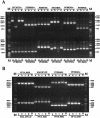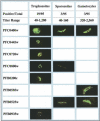High-throughput generation of P. falciparum functional molecules by recombinational cloning
- PMID: 15489329
- PMCID: PMC528923
- DOI: 10.1101/gr.2416604
High-throughput generation of P. falciparum functional molecules by recombinational cloning
Abstract
Large-scale functional genomics studies for malaria vaccine and drug development will depend on the generation of molecular tools to study protein expression. We examined the feasibility of a high-throughput cloning approach using the Gateway system to create a large set of expression clones encoding Plasmodium falciparum single-exon genes. Master clones and their ORFs were transferred en masse to multiple expression vectors. Target genes (n = 303) were selected using specific sets of criteria, including stage expression and secondary structure. Upon screening four colonies per capture reaction, we achieved 84% cloning efficiency. The genes were subcloned in parallel into three expression vectors: a DNA vaccine vector and two protein expression vectors. These transfers yielded a 100% success rate without any observed recombination based on single colony screening. The functional expression of 95 genes was evaluated in mice with DNA vaccine constructs to generate antibody against various stages of the parasite. From these, 19 induced antibody titers against the erythrocytic stages and three against sporozoite stages. We have overcome the potential limitation of producing large P. falciparum clone sets in multiple expression vectors. This approach represents a powerful technique for the production of molecular reagents for genome-wide functional analysis of the P. falciparum genome and will provide for a resource for the malaria resource community distributed through public repositories.
Figures




Similar articles
-
Novel antigen identification method for discovery of protective malaria antigens by rapid testing of DNA vaccines encoding exons from the parasite genome.Infect Immun. 2004 Mar;72(3):1594-602. doi: 10.1128/IAI.72.3.1594-1602.2004. Infect Immun. 2004. PMID: 14977966 Free PMC article.
-
Sterile protective immunity to malaria is associated with a panel of novel P. falciparum antigens.Mol Cell Proteomics. 2011 Sep;10(9):M111.007948. doi: 10.1074/mcp.M111.007948. Epub 2011 May 31. Mol Cell Proteomics. 2011. PMID: 21628511 Free PMC article.
-
[Production and molecular characterization of Plasmodium falciparum recombinant circumsporozoite protein with 37 NANP and 4 NVDP epitopes].Mikrobiyol Bul. 2017 Jan;51(1):41-51. doi: 10.5578/mb.46549. Mikrobiyol Bul. 2017. PMID: 28283009 Turkish.
-
[Immunology and molecular biology: targetting of a vaccine].Ther Umsch. 1986 Feb;43(2):148-54. Ther Umsch. 1986. PMID: 3515610 Review. French. No abstract available.
-
Current Challenges in the Identification of Pre-Erythrocytic Malaria Vaccine Candidate Antigens.Front Immunol. 2020 Feb 21;11:190. doi: 10.3389/fimmu.2020.00190. eCollection 2020. Front Immunol. 2020. PMID: 32153565 Free PMC article. Review.
Cited by
-
Infection with Plasmodium berghei boosts antibody responses primed by a DNA vaccine encoding gametocyte antigen Pbs48/45.Infect Immun. 2006 Apr;74(4):2043-51. doi: 10.1128/IAI.74.4.2043-2051.2006. Infect Immun. 2006. PMID: 16552033 Free PMC article.
-
High-throughput cloning and expression library creation for functional proteomics.Proteomics. 2013 May;13(9):1381-99. doi: 10.1002/pmic.201200456. Epub 2013 Apr 5. Proteomics. 2013. PMID: 23457047 Free PMC article. Review.
-
Generation and validation of a Shewanella oneidensis MR-1 clone set for protein expression and phage display.PLoS One. 2008 Aug 20;3(8):e2983. doi: 10.1371/journal.pone.0002983. PLoS One. 2008. PMID: 18714347 Free PMC article.
-
Development of the Gateway system for cloning and expressing genes in Entamoeba histolytica.Parasitol Int. 2009 Mar;58(1):95-7. doi: 10.1016/j.parint.2008.08.004. Epub 2008 Sep 12. Parasitol Int. 2009. PMID: 18822389 Free PMC article.
-
Identification of two new protective pre-erythrocytic malaria vaccine antigen candidates.Malar J. 2011 Mar 16;10:65. doi: 10.1186/1475-2875-10-65. Malar J. 2011. PMID: 21410955 Free PMC article.
References
-
- Aguiar, J.C., Hedstrom, R.C., Rogers, W.O., Charoenvit, Y., Sacci, J.B., Lanar, D.E., Majam, V.F., Stout, R.R., and Hoffman, S.L. 2001. Enhancement of the immune response in rabbits to a malaria DNA vaccine by immunization with a needle-free jet device. Vaccine 20: 275-280. - PubMed
-
- Bacarese-Hamilton, T., Bistoni, F., and Crisanti, A. 2002. Protein microarrays: From serodiagnosis to whole proteome scale analysis of the immune response against pathogenic microorganisms. Biotechniques Suppl: 24-29. - PubMed
-
- Ben Mamoun, C., Gluzman, I.Y., Hott, C., MacMillan, S.K., Amarakone, A.S., Anderson, D.L., Carlton, J.M., Dame, J.B., Chakrabarti, D., Martin, R.K., et al. 2001. Co-ordinated programme of gene expression during asexual intraerythrocytic development of the human malaria parasite Plasmodium falciparum revealed by microarray analysis. Mol. Microbiol. 39: 26-36. - PubMed
-
- Bowman, S., Lawson, D., Basham, D., Brown, D., Chillingworth, T., Churcher, C.M., Craig, A., Davies, R.M., Devlin, K., Feltwell, T., et al. 1999. The complete nucleotide sequence of chromosome 3 of Plasmodium falciparum. Nature 400: 532-538. - PubMed
WEB SITE REFERENCES
-
- http://www.malaria.mr4.org; Malaria Research and Reference Reagent Resource Center. - PubMed
-
- http://www.PlasmoDB.org; PlasmoDB.
Publication types
MeSH terms
Substances
LinkOut - more resources
Full Text Sources
Other Literature Sources
Research Materials
